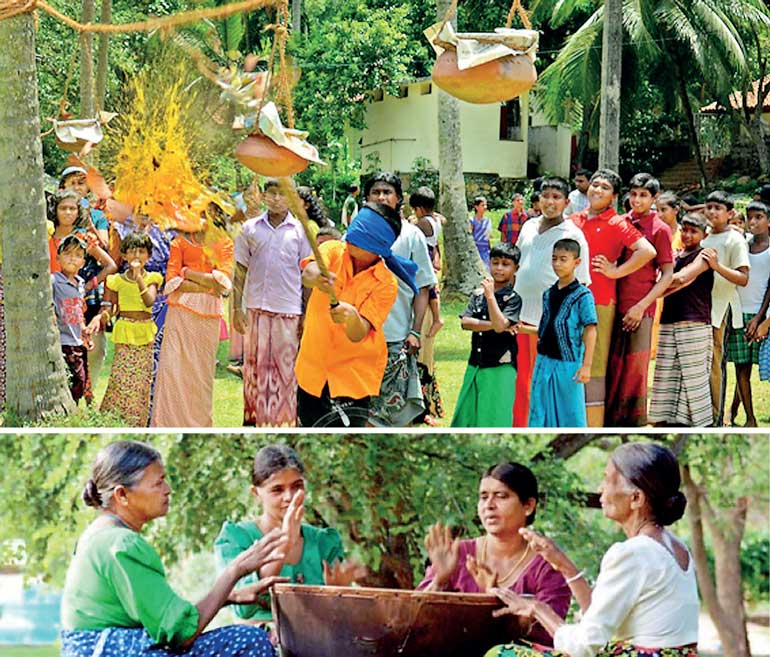Saturday Nov 15, 2025
Saturday Nov 15, 2025
Wednesday, 12 April 2017 00:00 - - {{hitsCtrl.values.hits}}
 By D.C. Ranatunga
By D.C. Ranatunga
Avilla avilla Sinhala Avurududda avilla
Varella varaella welle padimu ran onchilla
This opening line of a song by renowned singer Mohideen Baig announces the dawn of the Sinhala and Hindu New Year. It is one of the most popular Avurudu songs that is heard at this time of the year over the radio and through loudspeakers at Avurudu festivals.
Whatever hardships Sri Lankans may be experiencing, Avurudu is bound to be celebrated in style. The house would have got a fresh look by now. New clothes would have been either stitched or bought. Home-made sweetmeats ranging from kevum, kokis, aasmi, aggala and aluwa must be ready to adorn the Avurudu table along with the kolikuttu – the top of the range in bananas.
Just as much as the ‘rasa kevili’, clothes are a ‘must’ for the Avurudu. In the old days the Palayakat 80x80 (‘asuvata asuva’) sarongs for the males and ‘cheetta reddak’ for the females were the key items in the clothes list. Simple banian and sarong, and cloth and jacket were what everyone wore. The boys got shorts and a shirt while the girls got a frock. They were in the colour(s) recommended in the ‘Epa Panchanlaga litha’ – the almanac released a few weeks before Avurudu covering the period April-March – which was the last word where auspicious times were concerned. Generally, every household had a ‘litha’ hung or pasted on the wall mostly to see the ‘Avurudu chaarithra’ – observances for Avurudu and the Poya days and times throughout the year.
‘Avurudu’ begins with the observance of ‘nonagathe’ – also called the ‘punya kaalaya’ – considered to be the period when there are no auspicious times for any activity. It’s the time for religious observances when the entire family will go to temple, pay obeisance to the ‘loku hamuduruwo’ – the head monk, offer flowers and chant the stanzas. Some prefer to cease work and stay at home during this period and do the first visit in the New Year to the temple to offer betel to the monks and follow the rituals.
The new clothes are worn by all the members of the family at the time of the ‘ganu denu’ and ‘veda alleema’ – the commencement of work and transactions prior to sitting down to taste the first meal. The busy time for the mother starts earlier with the lighting of the hearth, boiling a pot of milk and preparing ‘kiribath’. The father in the meantime gets ready for the commencement of work.
At the auspicious time the family gathers, observe ‘pan sil’ and get down to begin work for the New Year. The father invariably uses the mammoty to cut a sod symbolising the start of the crop for the new season. The mother would possibly start sewing or read a few paragraphs from the ‘bana potha’ while the school-going children are made to read a book and write a few sentences. Transactions begin with the exchange of a few coins between the father and mother. The children pay homage to the parents buy offering betel and worshipping them reciting the relevant stanzas. Their ‘big moment’ comes when the parents give them money as ‘santhosam’. The married children visit their parents as the first outing for the New Year, bringing gifts to the family members and follow the tradition of paying respect to the elders. The Avurudu table will remain for the rest of the day to entertain the close relatives and others when they visit.
The mother will prepare a plate of sweetmeats for each neighbour who in turn reciprocates. That’s how ‘kevum’ and ‘kokis’ are always available in households for several days after Avurudu.
Avurudu promotes communal harmony when the community get together and play traditional games from ‘kotta pora’ (pillow fights), climbing the ‘grease polla’, to ‘kamba edeema’ (tug-o-war).
Similar rituals are observed in Tamil homes according to Hindu traditions.